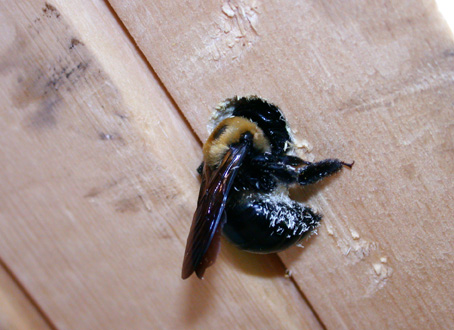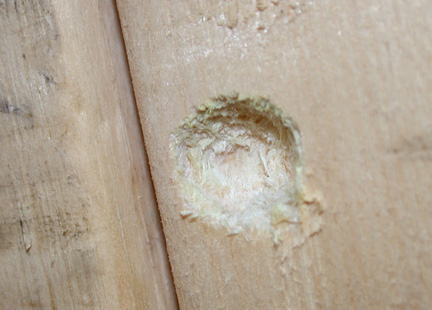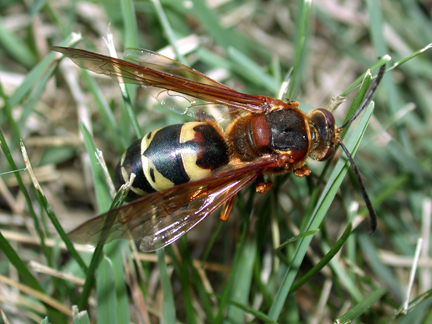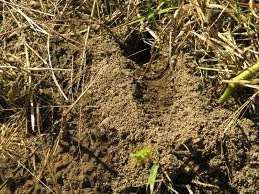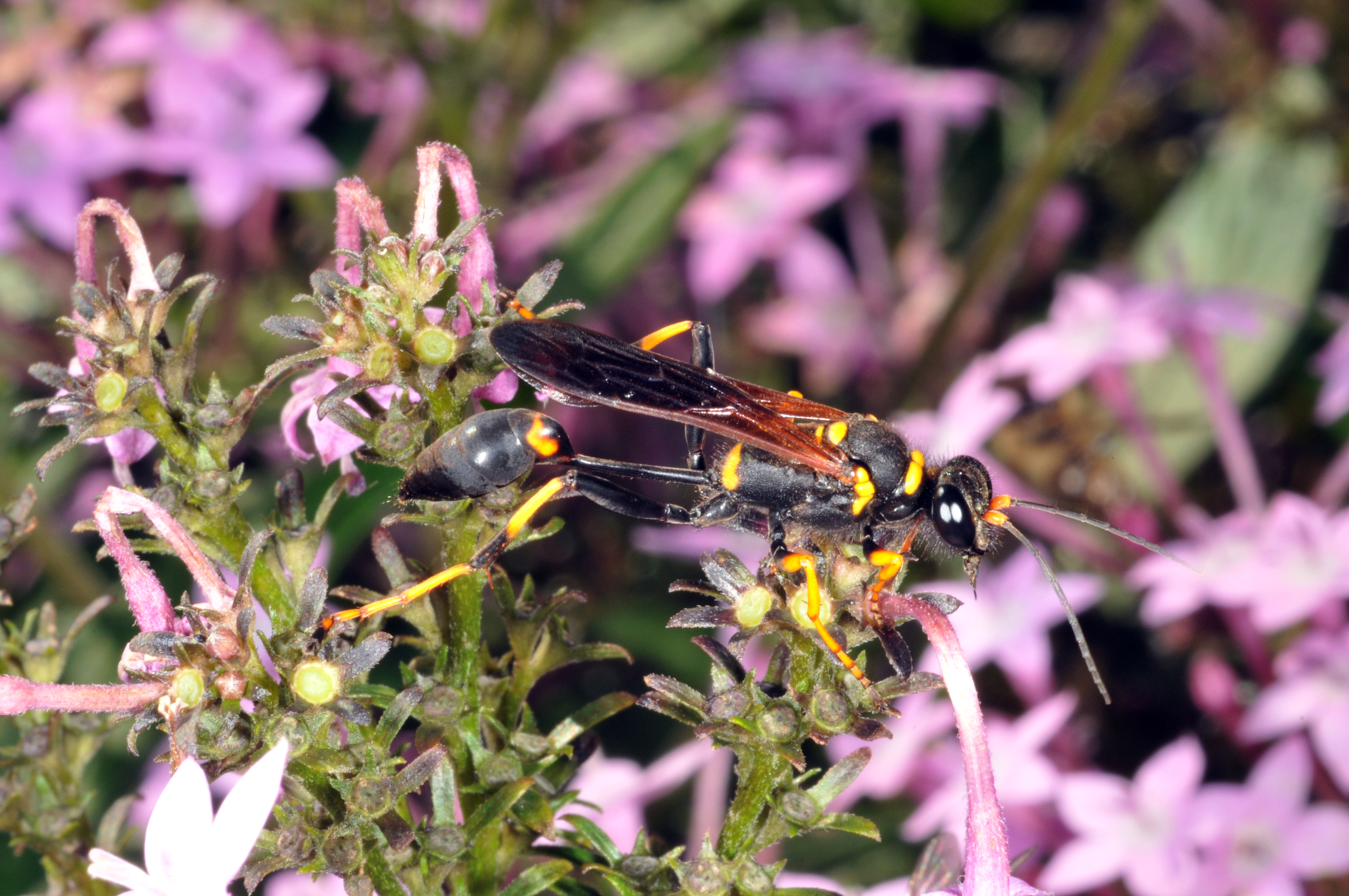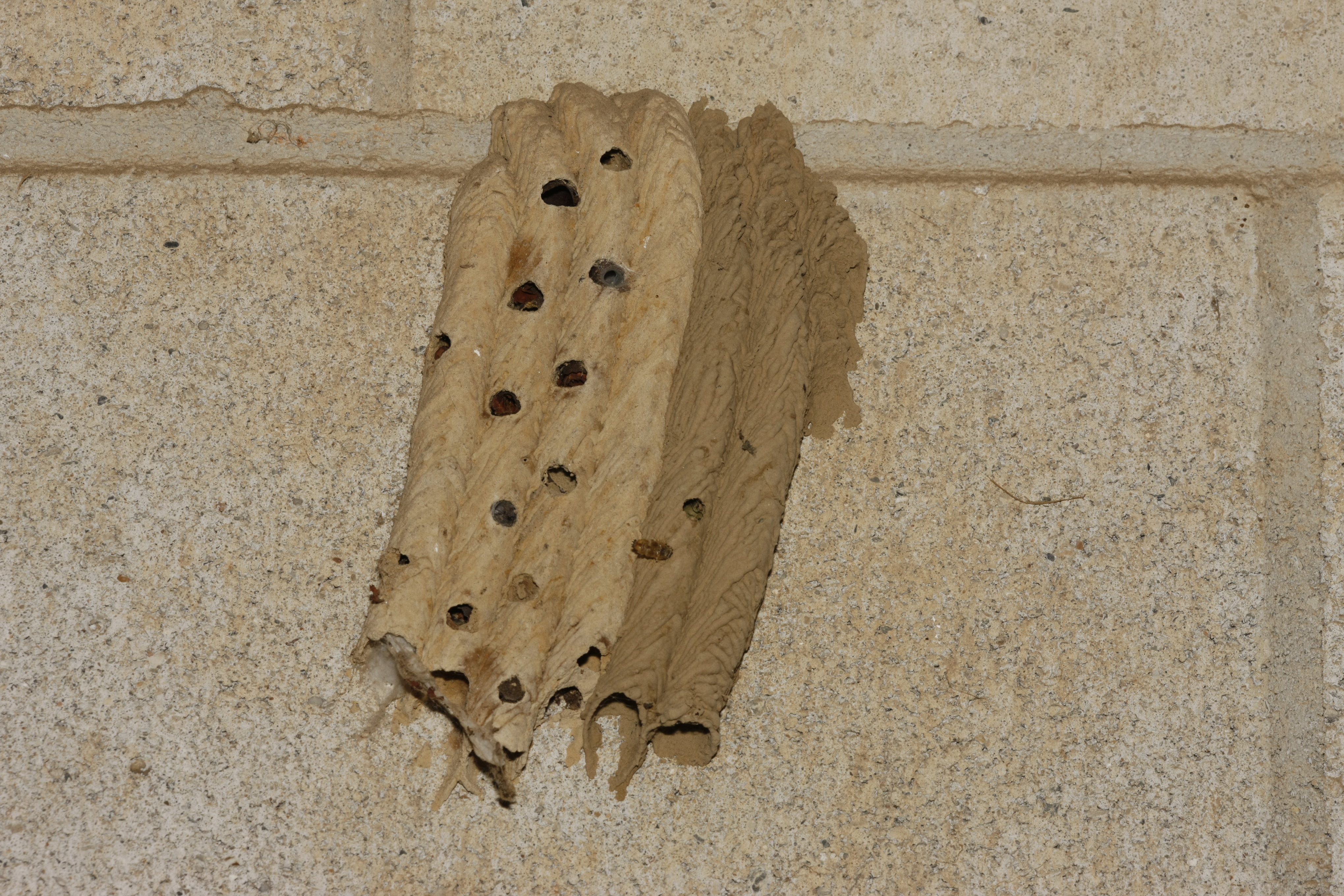HOUSEHOLD AND STRUCTURAL
SOLITARY BEES AND WASPS: CARPENTER BEE, CICADA KILLER, AND MUD DAUBERS
Timothy J. Gibb, Extension Entomologist
Photo credits: John Obermeyer
If you want to view as pdf, click here
A number of solitary bees and wasps reside in or around homes, yards and gardens. Because of their frequent association with humans, solitary wasps and bees often evoke a great deal of anxiety. However, solitary wasps and bees rarely sting, and then only if mishandled. Unlike their social relatives, the honey bee, bumble bees, paper wasps, hornets and yellowjackets (see Purdue Extension Publication E-44, Social Bees and Wasps), these solitary forms do not defend their nest or burrow.
Sometimes it is difficult to know if a bee or wasp is social or solitary, since some solitary forms exist in nesting aggregations. Generally, however, they can be distinguished by looking closely at the nest or burrow to see how many individuals are coming and going from a single entrance. Truly social wasps or bees exist in large colonies associated with an elaborate nest, thus many individuals will be active at the nest entrance or on the nest. By comparison, solitary wasps or bees are not associated with a large nest; in fact, only one individual normally occupies each nest or burrow.
The most common solitary bees and wasps include: carpenter bees, cicada killers and mud daubers.
CARPENTER BEES
The carpenter bee is a large robust, nearly black bee that bores tunnels into untreated wood of structures. It is often confused with bumble bees. However, bumble bees do not bore into wood, and they possess very hairy bodies with white, yellow or orange hair against a background of black hair. The carpenter bee, on the other hand, is less hairy and the abdomen is nearly hairless; yellow markings, if present, are greatly reduced and not as evident.
The entry hole of the carpenter bee is a nearly perfect circle about 1/2 inch in diameter. The hole goes straight into the wood for about 1-2 inches, then makes a 90 degree turn and runs with the wood grain for some 4-6 inches. The female bee fills 6-8 cells (separated from one another by partitions of wood pulp) with pollen and nectar. Each of these contains one bee larva. After the cells are completed, the female seals the tunnel and soon dies; larvae mature by late August and new adults emerge by early September. These adults forage for nectar but eventually reenter the tunnel (or a nearby one), clean it, and then overwinter in it. The cycle starts anew the following spring.
Carpenter bees may refurbish an existing tunnel instead of boring a new one. An infestation may persist for several years or more, and new tunnels may be constructed near old ones.
Carpenter bee boring into wood.
Carpenter bee hole.
Carpenter bees actually cause little serious damage, although continuous tunneling in wood may weaken the structure. In addition, these bees typically defecate around their tunnels producing unsightly stains on the wood. Perhaps the biggest problem is the annoyance and fear associated with the large carpenter bee. Males patrol the area and often fly about the faces of people; however, they cannot sting. The females do not defend their nest, but will sting if mishandled.
Control can be safely and effectively accomplished by dusting into the tunnels with 5% carbaryl (Sevin), leaving them open for a day or so, then plugging the opening with a dowel or wood putty to prevent future use.
CICADA KILLERS
The cicada killer is a large, yellow and black wasp that burrows into lawns, golf courses, nursery beds, etc. It is often mistaken for a hornet or yellow-jacket. However, the cicada killer is a solitary wasp, not a social wasp, although it exists in nesting aggregations. Such aggregations may contain from a few to a hundred or so individual burrows, and may persist for several years in the same location.
Each female cicada killer digs a burrow in well drained, light textured soil, typically in an area with full sunlight. The 1 1/2 inch diameter opening leads into an oblique tunnel that runs for 12-18 inches and reaches a depth of 6-10 inches. The female completes and stocks about four cells, each containing from one to three paralyzed cicadas on which eggs are laid. When eggs hatch the larvae bore into and feed on the cicada. Secondary tunnels are often built off the primary tunnel; thus each burrow may contain up to 16 larvae.
Cicada killer.
Cicada killer nest.
The larvae overwinter in their burrows, to emerge the next July as adults. Between late July and mid August, these new adults dig soil burrows, stock them with cicadas, and the cycle is repeated. Adults die by mid September. A large nesting aggregation results in unsightly mounds of soil that are characteristic of cicada killer activity.
Cicada killers are large, ominous looking wasps and evoke a good deal of fear. However, most of the wasps seen are males that patrol the nesting area. They may fly about, dive bomb, or even hover in front of people, but they can’t harm anyone. Females do not defend their burrows, and will sting only if mishandled.
Control of cicada killers is safely and effectively done by placing a small amount of 5% carbaryl (Sevin) dust down into the soil tunnel. For a large nesting aggregation, the area can be sprayed. In both cases, the tunnel entrances should be left open or else the wasps may begin excavating new tunnels.
MUD DAUBERS
Mud daubers are solitary wasps that construct small nests of mud on the sides of buildings, rafters of open structures, bridges and similar sites. These wasps are long and slender with a prominent thread-like waist. Each mud nest contains only a few cells in which wasp larvae are fed a diet of spiders caught and paralyzed by the female mud dauber. Larvae complete feeding and spin a cocoon but do not pupate until the following spring.
There are three different wasps known as mud daubers in Indiana. The black and yellow type builds a series of cylindrical mud cells, which are eventually plastered over with mud to form a smooth mud nest about the size of a fist. The organ-pipe mud dauber is a more robust, black species that builds the characteristic pipe organ tubes on the sides of smooth surfaces like walls and bridges. The third species is a beautiful metallic-blue to blackish wasp with blue wings. This one does not build its own mud nest but instead uses the abandoned nests of the black and yellow mud dauber.
Mud daubers do not defend their nests. Therefore, if desired, these mud structures can simply be picked off and discarded without fear of being stung.
Black and yellow mud dauber.
Organ-pipe mud tube.
READ AND FOLLOW ALL LABEL INSTRUCTIONS. THIS INCLUDES DIRECTIONS FOR USE, PRECAUTIONARY STATEMENTS (HAZARDS TO HUMANS, DOMESTIC ANIMALS, AND ENDANGERED SPECIES), ENVIRONMENTAL HAZARDS, RATES OF APPLICATION, NUMBER OF APPLICATIONS, REENTRY INTERVALS, HARVEST RESTRICTIONS, STORAGE AND DISPOSAL, AND ANY SPECIFIC WARNINGS AND/OR PRECAUTIONS FOR SAFE HANDLING OF THE PESTICIDE.
December 2016

It is the policy of the Purdue University Cooperative Extension Service that all persons have equal opportunity and access to its educational programs, services, activities, and facilities without regard to race, religion, color, sex, age, national origin or ancestry, marital status, parental status, sexual orientation, disability or status as a veteran. Purdue University is an Affirmative Action institution. This material may be available in alternative formats.
This work is supported in part by Extension Implementation Grant 2017-70006-27140/ IND011460G4-1013877 from the USDA National Institute of Food and Agriculture.
1-888-EXT-INFO
www.extension.purdue.edu
Order or download materials from www.the-education-store.com

